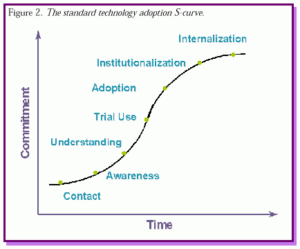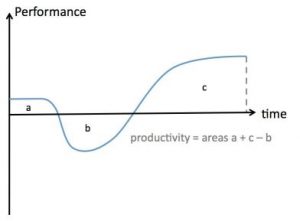Why Change Management Oriented Projects Are Hard and How To Succeed Anyway
Many projects have an S shaped pattern that is our adoption success curve for our effort. Understanding our project adoption and productivity curves will help us ensure our projects are successful.
One of the greatest insights I gained out of my time at the Software Engineering Institute had nothing directly to do with software. Instead it was the notion of technology adoption and change “S” curve. This S curve described how an organization generally went through the effort to adopt a new technology, technique, policy, or whatever change was being implemented.
Change Adoption Proceeds In An S Curve Pattern
The S curve suggests that in starting out, things are pretty easy. One talks about and researches the need and the technology or project management tool that one believes is needed to help the organization to improve. Once we get past the early stage, however, things start to get a bit tougher.
When it comes to implementing and changing, the slope of progress and level of effort and resistance increases. Sometimes, as suggested by the middle of the S, we feel like we are facing a steep cliff that is un-scalable. It is this point where many efforts struggle and fail. For me, just realizing that every change oriented project faces this steep climb, helped me to anticipate and persevere during this time. Before I understood this phenomena, I realized that I often was not helping as I expressed my frustration at delays and flagging support. Once I realized that just about all change and improvement projects go through this curve, I found I could more effectively help, encourage and lead during this period.
The key element during the middle of the S curve involves working with people one on one, to help them keep at it. This is where we help to remove barriers, eliminate unneeded work, and help guard against unwanted distractions. In many cases, people just need to realize that they are not on their own and that someone will go to bat for them if the new way of doing things is not perfect the first time. In this SEI graphic that I’m using to illustrate this concept, I would replace “commitment” with “effort” or “difficulty.” Also the time that goes by at the steepest part of the curve can seem like forever, where here it looks like it is something that is quick. One large aerospace engineering company reported that to adopt a major change and completely institutionalize it took them an average of seven years.
Productivity Dips Prior To Finally Improving
This is where we recognize the next big insight I gained at the Software Engineering Institute. Again, it has little directly to do with software. This next insight is that when implementing a project that changes how we do work, we will often NOT be as productive as we were with the old approach. This part is tricky. If we tell more senior management up front that we’ll not be instantly better, the project might not get approved in the first place. The key to this insight is to help people making the change (and management) to realize that we will experience some less productive times while we are coming up to speed with the new approach. Many people will recognize the benefit of the new approach, but will need to understand that it will take some time to get really good at it. Our efforts seemed to go more smoothly when we recognized this and helped everyone through this tough period.
My first hint at this kind of change phenomena happened in high school. I had taught myself to type. I had the fastest four fingers around. No one, that I knew, could type faster with more accuracy than I could. However, a lot of people were typing using all their fingers. I decided that I should type that way also. Boy, that was hard. I got really bad for too long a time. I was not as productive typing software or class papers as I had been. I almost gave up on it. But I kept at it and finally mastered it. In the future, in the working world after school, I would have people come over to my desk and ask me what I was doing. They thought I was rapidly pounding on my keyboard for some reason. I was just typing. Very fast. Very loud. Very accurate. This one little experience helped me realize that improvement efforts were often hard, followed a predictable pattern, and could make a huge difference in how productive I was.
With any project that changes how we do business it is good to recognize two things. The first is we will face an uphill challenge at some point that is best handled with understanding and perseverance. The second is that there will most probably be some temporary productivity loss and helping both the implementers and senior management recognize this characteristic will help us get through it successfully.
Have you seen these kind of adoption and productivity characteristics in your change oriented projects?



9 thoughts on “Why Change Management Oriented Projects Are Hard and How To Succeed Anyway”-
Pingback: Good Results Will Inevitably Degrade With Time Unless We Act To Prevent It – Project Management Tools That Work
-
Pingback: The Right Project Management But The Wrong Project? – Project Management Tools That Work
-
Pingback: Shortcuts do not exist – Project Management Tools That Work
-
Pingback: Lessons Learned From The California Drought
-
Pingback: In Project Management — Patience Is Not A Virtue
-
Pingback: Seven Ways To Make That “Silver Bullet” Work
-
Pingback: If The Talk Is All Bad Then There Are Great Opportunities
-
Pingback: Do 70% of your change efforts fail?
-
Pingback: The Official Plan: Four Project Management Planning Secrets
Comments are closed.